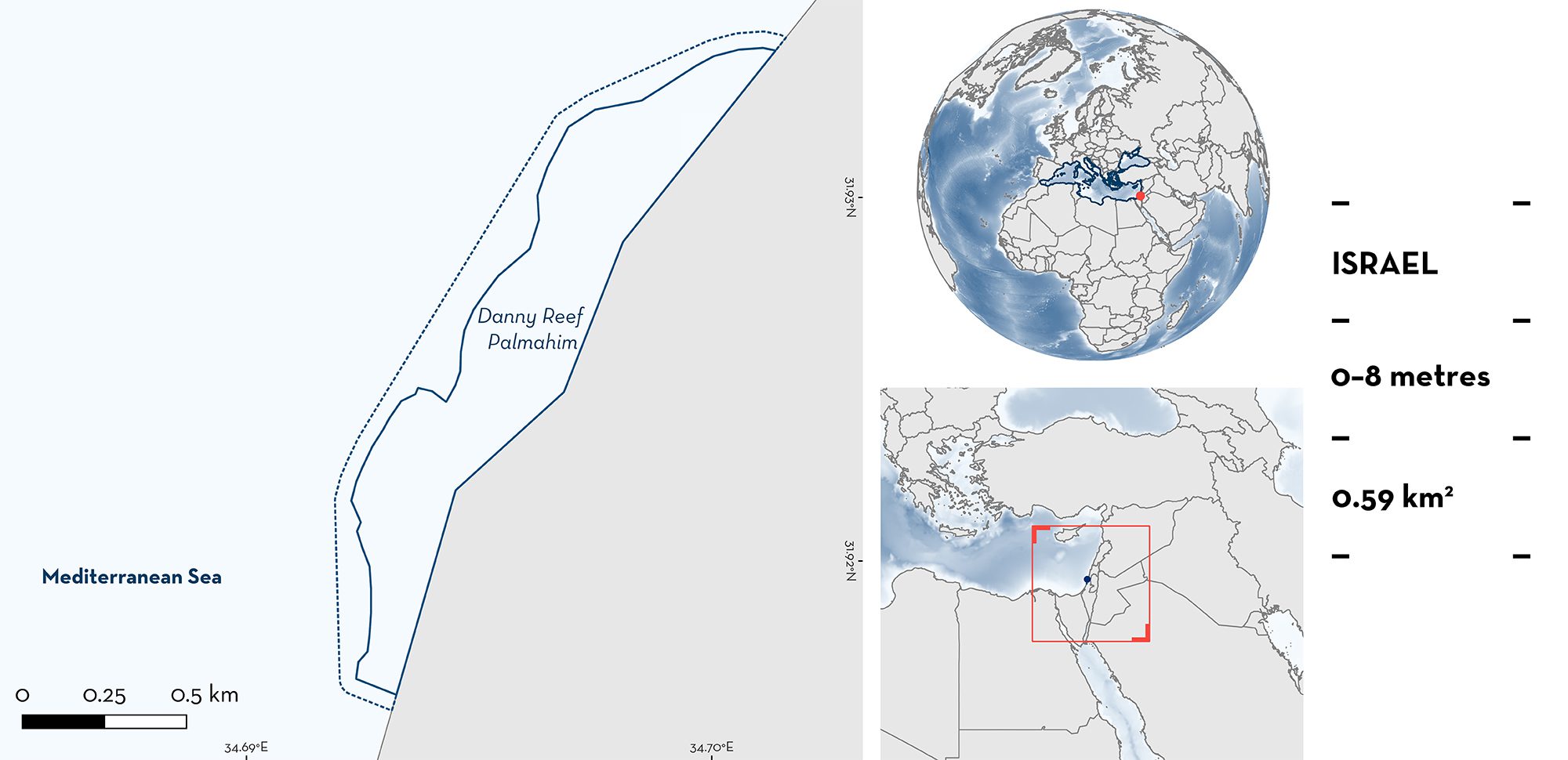ISRA FACT SHEETS
ISRA FACT SHEETS
MEDITERRANEAN AD BLACK SEAS REGION
Danny Reef Palmahim
Summary
Danny Reef Palmahim is located in the coastal waters of Israel. The area surrounds the formation of the Kurkar rock and consists of varied habitats in shallow water <8 m deep, including detached abrasion tables, shallow sandy lagoons, a submerged Kurkar rocky reef, and patches of sandy substrate. Within this area there are: threatened species (e.g., Blackchin Guitarfish Glaucostegus cemiculus); reproductive areas (e.g., Common Stingray Dasyatis pastinaca); and undefined aggregations (Marbled Stingray Dasyatis marmorata).
Download factsheet
Danny Reef Palmahim
DESCRIPTION OF HABITAT
Danny Reef Palmahim is situated in the eastern Mediterranean Sea, Israel. The area is formed by a Kurkar reef, an aeolian quartz sandstone with carbonate cement. This sandstone is found on the Levantine coast of the Mediterranean Sea from Türkiye to the northern Sinai Peninsula. The area surrounds the formation of the Kurkar rock and consists of varied habitats in shallow water <8 m deep including detached abrasion tables, shallow sandy lagoons, a submerged Kurkar rocky reef, and patches of sandy substrate. The seascape complexity of the rocky substrate is characterised by many concave and convex configurations, including prominent overhangs, burrows, and crevices. This complex structure creates many niches and is therefore rich in algae, crabs, snails, and other invertebrates.
This Important Shark and Ray Area is benthopelagic and is delineated from inshore and surface waters (0 m) to 8 m based on the bathymetry of the area.
CRITERION A
VULNERABILITY
Three Qualifying Species considered threatened with extinction according to the IUCN Red List of Threatened SpeciesTM regularly occur in the area. These are the Critically Endangered Blackchin Guitarfish (Kyne & Jabado 2019) and Common Guitarfish (Jabado et al. 2021a), and the Vulnerable Common Stingray (Jabado et al. 2021b).
CRITERION C
SUB-CRITERION C1 – REPRODUCTIVE AREAS
Danny Reef Palmahim is an important reproductive area for three ray species. All reports described below were from visual, in-water surveys, and from citizen scientists, and demonstrate the regular and predictable nature of species sightings that aggregate for reproductive purposes. The number of observations refers to the number of times the species has been sighted, and the number of individuals is the total individuals seen across all combined observations (the MECO project unpubl. data 2023).
Common Stingrays aggregate seasonally in this area, with females aggregating to gestate and neonates staying in the area during the early stages of their lives. Common Stingrays were reported each year since 2015 comprising 178 observations of 3,250 individuals. During the boreal spring (May–June), adults of both sexes are observed (129 observations). Pregnant females with noticeably distended abdomens were documented 30 times and a single parturition event was observed in June 2023. In July, adults leave the area with few observations for the rest of the year (0–8 observations per month). Between May and early November, observations of neonates and young-of-the-year have been recorded 45 times (~1,500 individuals). Neonates were identified by visual size estimates, with support from other features, such as the length of the tail and a body without scars (Barash et al. 2018; the MECO project unpubl. data 2023).
Common Guitarfish aggregations have been reported in the area each year since 2018, with 34 observations recorded of 529 individuals. In most cases, aggregations were recorded at night and only two observations were reported from the daytime. During May–June, adults of both sexes were observed (15 observations). Later in the year from August–December, neonates and young-of-the-year have been increasingly reported over the years, indicating that this area is important for the early life stages of this species. Sixteen aggregations of neonates and young-of-the-year were recorded, often comprising large numbers of up to 80 individuals (Barash et al. 2018; the MECO project unpubl. data 2023). Their estimated size ranged 20–40 cm total length (TL). The species’ size-at-birth is ~25 cm TL and they have a size range of 22–46 cm TL for the age class 0 (Ismen et al. 2007), indicating that these were neonates and young-of-the-year.
Blackchin Guitarfish aggregations have been increasingly reported annually since 2013, with 41 observations of 305 individuals recorded. During June, adults of both sexes are observed (27 observations). From the end of August to October, only neonates and young-of-the-year have been recorded (17 observations; Barash et al. 2018; the MECO project unpubl. data 2023). These range in estimated size from 20–40 cm TL and most were likely to be neonates considering the size-at-birth of 34 cm TL (Kyne et al. 2020). The different seasonality of adults and neonates suggests that parturition occurs in the area in August. The same timing for parturition is also observed in nearby areas (e.g., Dalia Beach).
CRITERION C
SUB-CRITERION C5 – UNDEFINED AGGREGATIONS
Danny Reef Palmahim is an important aggregation area for one species of ray.
Marbled Stingrays aggregate seasonally in the area, with reports each year since 2016 comprising 42 observations of 582 individuals. The reason for their aggregation is unclear, although during spring (May–June) gestating females with distended abdomens were documented seven times and juveniles have also been reported (six observations, 146 individuals; Barash et al. 2018; the MECO project unpubl. data 2023). Further information is required on the function of these aggregations including to understand if they are related to reproduction.
Download factsheet
SUBMIT A REQUEST
ISRA SPATIAL LAYER REQUEST
To make a request to download the ISRA Layer in either a GIS compatible Shapefile (.shp) or Google Earth compatible Keyhole Markup Language Zipped file (.kmz) please complete the following form. We will review your request and send the download details to you. We will endeavor to send you the requested files as soon as we can. However, please note that this is not an automated process, and before requests are responded to, they undergo internal review and authorization. As such, requests normally take 5–10 working days to process.
Should you have questions about the data or process, please do not hesitate to contact us.


